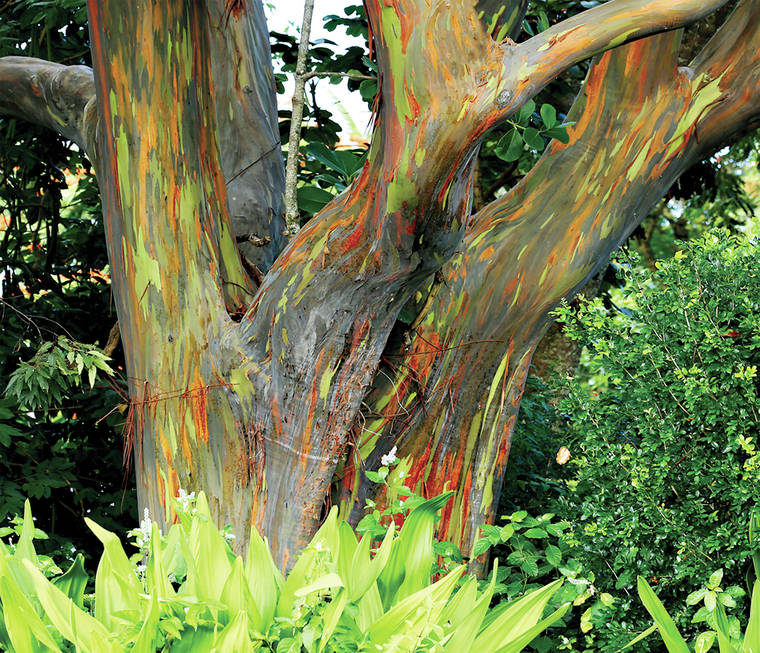Tropical Gardening: Painted trees are special at Kona Cloud Forest Sanctuary

Photo courtesy of KELLY DUNN A Eucalyptus deglupta tree.
The painted eucalyptus, Eucalyptus deglupta, sometimes called rainbow eucalyptus or camouflage tree, is a sight to behold. Thanks to Kelly Dunn and his Painted Trees of Hawaii, these beautiful trees are being protected on our island.
The painted eucalyptus, Eucalyptus deglupta, sometimes called rainbow eucalyptus or camouflage tree, is a sight to behold. Thanks to Kelly Dunn and his Painted Trees of Hawaii, these beautiful trees are being protected on our island.
Of more than 500 species of eucalyptus, this is the only one found growing naturally north of the equator. It is native to the rain forests of the Philippines, Indonesia and New Guinea. It is related to ohia, so the flowers also attract our native honeycreepers.
ADVERTISING
Painted Trees of Hawaii is an educational nonprofit foundation. Dunn, CEO-president, resides in the Kona Cloud Forest Sanctuary. He created the foundation to help increase awareness of the trees through lectures, events and daily tours at the sanctuary.
The foundation has an active board of directors that is involved with the forest, community events and online activities. Recently, Trip Advisor awarded the Kona Cloud Forest Sanctuary with its 2019 Certificate of Excellence.
The foundation helps maintain the forest through many of its volunteers and community service workers. If you and your group want to volunteer, contact the foundation. All tours are by phone appointment only.
Call 640-3888 for tours and volunteering. Check out the website at PaintedTreesOfHawaii.org.
Tour guests will receive a charitable contribution letter by email for their tax records.
•••
Global warming is no longer a theory, and is being accepted as fact by most scientists and governments. This will affect our islands by causing more extremes such as drought, floods and severe storms.
We might not be able to do much about other parts of the world, but here at home we as individuals are either part of the solution or part of the problem. Just think — if each one of us on the Big Island, plant only 10 trees this year, we will have planted more than 1 million.
Trees not only produce oxygen, they supply shade, act as windbreaks and lock up carbon, which is the main cause of global warming. Scientists have shown that about 25% of carbon dioxide is sequestered by forests each year, so the more forests we plant the more we reduce the effects of global warming.
Many of Hawaii’s forests and forest watersheds are threatened. Not much can be done to stop foreign governments from forest destruction, but we can do a lot to protect and plant forests here.
In East Hawaii, many ohia forest areas are suffering from rapid ohia death. Other forested areas are being lost to expanding urbanization.
Unless the owners of the land really commit to protecting the forested lots, they are bulldozed and flattened.
In West Hawaii, the same situation occurs with private lands being subdivided and cleared. One exception is the 2,000-acre Kaloko Mauka, adjacent to the ‘O‘oma Forest Reserve. This is one of the most accessible native forests in West Hawaii.
It — among other high-elevation areas of Hawaii — is being developed for agriculture and residential activities. However, county planners are making an effort to encourage developers and landowners to protect the forest by placing requirements that the lots remain in forest.
The county also is requiring a forest management plan and allowing owners to dedicate to native forest or tree crops, thus reducing the tax burden.
Information about how to apply for agriculture and conservation dedications can be obtained from the county tax office.
Much of Kaloko Mauka is still covered with native forest and is unique cloud forest. Although it is sparsely populated, the gardens of residents are a fascinating mixture of hydrangeas, hoawa, calatheas, camellias, koa and kopiko. The area abounds with ancient ohia and gigantic tree ferns, some of which are 30 feet or more in height. These ferns can be more than 100 years old, since the trunks only grow 2-3 inches per year.
The native forest contains many rare and endangered species that local residents are committed to protecting. These programs allow residents to dedicate and manage their properties to enhance this important and unique watershed. They are administered through the state Department of Land and Natural Resources Forestry Division, Hawaii Island Land Trust and Moku O Keawe Land Conservancy.
Kaloko Mauka is the home of the Hawaiian hawk, apapane, iiwi, elepaio, amakihi and many other endemic and exotic birds. Kaloko Mauka was identified as essential wildlife habitat and forest watershed.
It is the goal of residents of Kaloko Mauka to set an example that they can live in harmony with the forest and still have homes and some “forest friendly” agriculture activities. This is essential if our island is to have the rainfall and watershed needed to supply communities at lower elevations.
•••
Tropical forests include not only trees but understory palms, bromeliads, orchids, ferns and bamboos.
Many palms worldwide are endangered because of the destruction of rain forests. Fortunately, Hawaii is becoming a kind of Noah’s Ark thanks to the efforts of the Hawaii Island Palm Society, bamboo society, orchid societies, rhododendron society and other concerned groups.
Not only is it vital to protect our remaining Hawaiian forests, but to reforest those abandoned cane lands of Hamakua, Puna, Ka‘u and Kohala with diverse forests, thus ensuring valuable resources for future generations.
For more information about forest planting and management, contact University of Hawaii Extension forester, J.B. Friday at 959-8254 or jbfriday@hawaii.edu.


